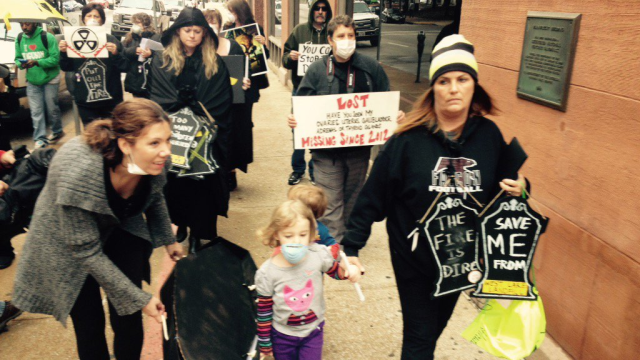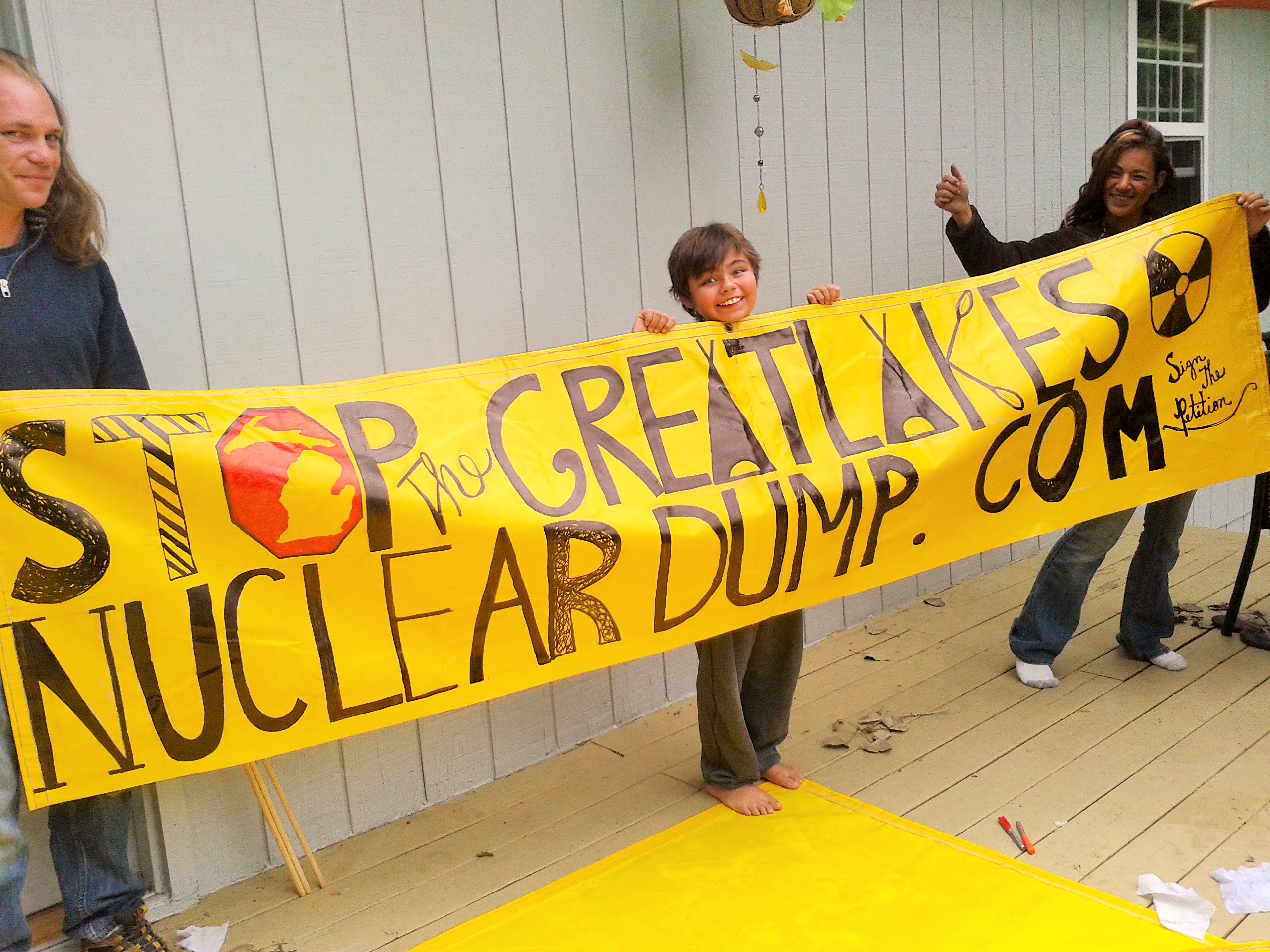 Just Moms STL leaders Dawn Chapman and Karen Nichols during protest in St. Louis in fall of 2015. The group is now headed to Washington to seek help from EPA Administrator Gina McCarthy. (Kevin Killeen/KMOX)As reported by Brian Kelly at CBS St. Louis, Just Moms STL from Bridgeton, Missouri and Water Warriors, including Water You Fight For in Flint, Michigan are standing in solidarity. They are demanding action from U.S. Environmental Protection Agency (EPA) Administrator Gina McCarthy, regarding, respectively: a leaking radioactive waste dump in the flood plain of the Missouri River, upstream of drinking water intakes for metro St. Louis, now at risk from an underground garbage dump fire burning less than 1,000 feet away; as well as the lead-poisoning drinking water catastrophe in Flint, MI resulting from the switch to highly corrosive river water, from Great Lakes water, without performing legally required anti-corrosive chemical treatment.
Just Moms STL leaders Dawn Chapman and Karen Nichols during protest in St. Louis in fall of 2015. The group is now headed to Washington to seek help from EPA Administrator Gina McCarthy. (Kevin Killeen/KMOX)As reported by Brian Kelly at CBS St. Louis, Just Moms STL from Bridgeton, Missouri and Water Warriors, including Water You Fight For in Flint, Michigan are standing in solidarity. They are demanding action from U.S. Environmental Protection Agency (EPA) Administrator Gina McCarthy, regarding, respectively: a leaking radioactive waste dump in the flood plain of the Missouri River, upstream of drinking water intakes for metro St. Louis, now at risk from an underground garbage dump fire burning less than 1,000 feet away; as well as the lead-poisoning drinking water catastrophe in Flint, MI resulting from the switch to highly corrosive river water, from Great Lakes water, without performing legally required anti-corrosive chemical treatment.
The groups put out a joint press release entitled "Moms from Flint, MI and St. Louis, MO to Address EPA's Failure to Protect Children and Families."
Also featured at the National Press Club press conference were Ed Smith of Missouri Coalition for the Environment (MCE), and Gail Thackery of Franciscan Sisters of Mary.
In early February, the U.S. Senate passed a bill that would transfer authority from EPA to the U.S. Army Corps of Engineers, at the West Lake Landfill. As reported by the Washington Post, of great frustration and growing alarm to local residents, EPA has long settled for merely "capping" and abandoning the radioactive wastes in situ, despite the risks of flooding (and now fire), not to mention the risks to public health from leakage that has already taken place over the past 43 years. Advocates like Just Moms STL and MCE have long pushed for ACE to remediate the situation, by cleaning up the site, and removing the wastes to a less vulnerable location. The bill now is before the U.S. House Energy and Commerce Committee.
In 2015, Beyond Nuclear board member Kay Drey in St. Louis published a pamphlet, warning about the risks to the drinking water supply of metro St. Louis from the West Lake Landfill. It includes a map, showing that the radioactive wastes at West Lake Landfill are upstream of the drinking water intakes for North County and the City of St. Louis, on the Missouri and Mississippi Rivers.
In a recent edition of the Journal of Environmental Radioactivity, Beyond Nuclear board member Lucas Hixson co-authored a study confirming that radium and uranium had migrated off-site from West Lake Landfill, into neighboring communities.
Regarding the Flint drinking water catastrophe, EPA Region 5 (Midwest) Administrator Susan Hedman resigned on Feb. 1. An EPA whistleblower, Miguel Del Toral, played a very significant role in raising alarms about the lead poisoning of the Flint drinking water supply, but he was largely to entirely "handled" -- in the words of a gloating State of Michigan official, to concerned Flint Mom Lee-Anne Walters, whose four-year-old son Gavin has been lead poisoned -- for many months on end. Walters, who alerted Del Toral to the lack of corrosion control in the first place, was recently awarded the "Momma Bear Award" by the Virginia Tech safe drinking water team that first tested and revealed the extent of Flint's drinking water lead-poisoning, again at Walters' instigation.
Beyond Nuclear recently published an article at Counterpunch entitled "After Flint, Don't Let Them Nuke the Great Lakes Next!", focused on the proposal to dump radioactive wastes on the Great Lakes shore, again with EPA complicity (Ontario Power Generation's DGR, short for Deep Geologic Repository). The Great Lakes are the drinking water supply for 40 million people in eight U.S. states (including, again now Flint, Michigan), two Canadian provinces, and a large number of Native American First Nations.
In recent weeks, in the aftermath of the Flint revelations, EPA Administrator McCarthy sent a nation-wide directive to the entire EPA workforce, calling for EPA employees to raise the alarm regarding matters vital to public health. The agency suppressed and downplayed concerns about Flint raised by Del Toral, not to mention Flint families, keeping the public in the dark for many long months.
As reported by KMOX/CBS St. Louis and mentioned in the joint Moms' press release, Lois Gibbs of the Center for Health, Environment, and Justice, joined the St. Louis and Flint Moms, in their call for positive, protective action from EPA. Gibbs rallied concerned Moms decades ago in Love Canal, NY, to protect endangered children from leaking toxic wastes in their community. Gibbs continues that work today, but now nationwide.
As Beyond Nuclear conveyed in a recent presentation in Port Huron, MI, concerned Moms with sick children have likewise raised alarms about nuclear power's radioactive dangers.
A case in point is the Sauer family in Morris, IL, home to the Dresden nuclear power plant and General Electric-Morris high-level radioactive waste storage facility. After their daughter Sarah, at age 7, was diagnosed with a rare form of childhood brain cancer on April 26, 2001, her mother Cynthia and father Joe devoted years to uncovering what carcinogenic hazards lurked in the area's environment. Their tireless, thankless work significantly helped reveal massive leaks of hazardous trititum into the drinking water supply of Godley Park District, IL -- immediately adjacent to, and downstream from, the Braidwood nuclear power plant.
Exelon Nuclear, as well as the IL EPA, had concealed massive leaks (numerous leaks, measuring in the millions of gallons each) of radioactive tritium into groundwater for a decade.
Thankfully, Sarah Sauer survived, and is in remission. But not all children in her area were so lucky.
 Jeremy Whitmore and Valerie Daggett get an assist in saving the Great Lakes from the next generation in Port Huron, MI!Another example of Moms speaking out against radioactive risks comes from Port Huron, MI itself. There, Valerie Daggett, along with her fiancé, Jeremy Whitmore -- recent co-recipients of the Great Lakes Environmental Alliance's "Kay Cumbow Award" for anti-nuclear activism -- organized a rally against the DGR last August. And sure enough, Valerie's little one was smack dab in the middle of the rally (see photo, left)! In this case, the activism is in hopes of preventing a drinking water catastrophe at the DGR.
Jeremy Whitmore and Valerie Daggett get an assist in saving the Great Lakes from the next generation in Port Huron, MI!Another example of Moms speaking out against radioactive risks comes from Port Huron, MI itself. There, Valerie Daggett, along with her fiancé, Jeremy Whitmore -- recent co-recipients of the Great Lakes Environmental Alliance's "Kay Cumbow Award" for anti-nuclear activism -- organized a rally against the DGR last August. And sure enough, Valerie's little one was smack dab in the middle of the rally (see photo, left)! In this case, the activism is in hopes of preventing a drinking water catastrophe at the DGR.
But of course, such organizing, by Moms and others, to protect children against radioactive dangers, goes back many decades. Women's Strike for Peace began protesting against nuclear weapons testing in the 1950s. They helped convert the likes of Dr. Benjamin Spock to the cause, and assisted the likes of Dr. Barry Commoner with his Tooth Fairy Project, documenting hazardous Strontium-90 build-up in children's teeth, due to nuclear weapons testing fallout worldwide. The work led to passage of the Atmospheric Test Ban Treaty in the early 1960s.
Also standing in solidarity with Flint to protect precious, vital drinking water supplies is the Ohio Valley Environmental Coalition (OVEC), reminding the nation about the Charleston, West Virginia drinking water catastrophe that occurred just two years ago, when toxic chemicals leaked into the Ohio River.
But as famed consumer advocate Erin Brockovich and Environmental Working Group president Ken Cook have warned in a TIME op-ed, "It's Not Just Flint -- American Has a Scary Water Problem."
Nationwide and worldwide solidarity, to protect irreplaceable clean, safe drinking water against toxic and radioactive hazards, must continue for a long time to come.





 September 21, 2017
September 21, 2017

